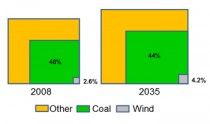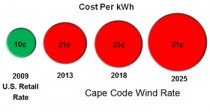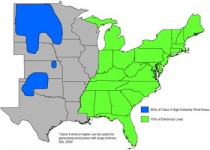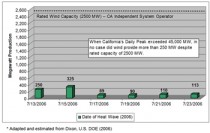By Dr. Frank Clemente, Energy Facts Weekly
“… taxpayers will be required to pay to build Cape Wind and then required to buy its products at twice normal rates, opponents might have more success if they pointed out what a lousy deal it is ...” - Wall Street Journal, 2010
Electricity from wind is a worthwhile addition to electric grids throughout the United States. Fuel diversity is the linchpin of the electric reliability that serves as the foundation of modern society. But, as the forecast released last month by the Energy Information Administration in their International Energy Outlook 2010 confirms, wind-based electricity generation will play a very minor role in the electric supply system over the next several decades.
The Limited Role of Wind in U.S. Power Generation
In fact, wind power is projected to peak about 2015 when 4.7% of electricity will be produced by wind. Thus, after this current spate of turbine construction subsides, the relative role of wind will actually decline through 2035. (enlarged)

The constraints upon large-scale deployment of wind power are straightforward and well known. There is no free lunch in the energy business and the tab associated with greatly expanded dependence upon wind generation is just too risky and expensive - and probably not even possible.
The Cost of Cape Cod Wind-Based Electricity
Building 130 wind turbines, each as high as the Statue of Liberty, in Nantucket Sound will be expensive indeed. Beacon Hill Institute in Massachusetts estimated taxpayer funded subsidies alone will reach one billion dollars - giving wind investors an unseemly 25% return on equity. And then the real costs begin as electric rates follow an ever escalating trajectory based upon increases to which all parties have already agreed.

Cape Cod: The High Cost of Wind Generation (enlarged)
“This confirms the worst fears of many Massachusetts rate players and businesses,” - Alliance to Protect Nantucket Sound
Of course, most wind power in the U.S. will come from onshore but that is expensive as well. Professor Jay Apt at Carnegie Mellon University estimated wind based electricity on land could reach 20 cents per kilowatt hour - double that of coal even after CO2 was captured and stored. The Heritage Foundation came up with similar numbers, stating that the average family in the U.S. would pay $340 a month for electricity from wind as opposed to $189 from coal. But even this alarming number surely underestimates the cost of wind since coal provides half of the electricity in the United States and wind could never reach that scale of deliverability.
Wind Resources Abound - but on the Farthest Horizon

Geographic Dissonance: 80% of the Class 4 Wind is far removed from 70% of the Electricity Load (enlarged)
Indeed, an extensive study by major U.S. power pools found that for the Eastern U.S. just to get 5% of its power from wind will require over 10,000 miles of extra high voltage transmission lines. Considering that it takes about seven years to get one line approved and built, the prospects that wind will make a significant difference are about as remote as North Dakota.
Wind Takes Hot Days Off - And Cold Ones Too
The intermittency of wind is its real Achilles heel. Modern societies are replete with machines and electronic equipment based on the presumption of reliable electricity. Wind’s variability means it must be constantly backed up by another source - most likely natural gas with a price that can spike literally overnight. Thus, the cost involves not only building wind turbines and new transmission lines but also building standby natural gas peaking plants - a true double whammy for electric rates to families and businesses.

Hot? Wind Generation’s Performance during a California Heat Wave (enlarged)
COLD?
“During the January 2010 cold snap in the United Kingdom, wind was able to generate power at only 4% of its rated capacity. Jeremy Nicholson, Director of an Industrial Energy Consumers group, noted, “Even if we had 30 gigawatts of wind power, it wouldn’t have contributed anything of any significance this winter...” (UK, Telegraph)
NEVER ?
“Seven wind turbines launched near Bali during the United Nations Climate Change Conference in December 2007 have failed to deliver any of their promised power ... District head W. Sumarta acknowledged that the seven wind plants have never been operational .... ‘they are nothing more than monuments’ he said ... each wind turbine cost $325,000 US ...” - Jakarta Post, May, 2010
Major References:
1. Wall Street Journal, 5/12/2010
2. Alliance to Protect Nantucket Sound
3. Telegraph (UK), 1/11/2010
4. Jakarta Post, 5/2010
5. Heritage Foundation
6. EIA DOE
Dr. Clemente is a Professor at Penn State University where he specializes in research on the socioeconomic aspects of energy policy. His work has appeared in World Oil, Public Utilities Fortnightly, Oil and Gas Journal and a variety of other energy related media. The materials presented here are solely the responsibility of the author and do not represent Pennsylvania State University in any manner. Sign up for newsletter here.




